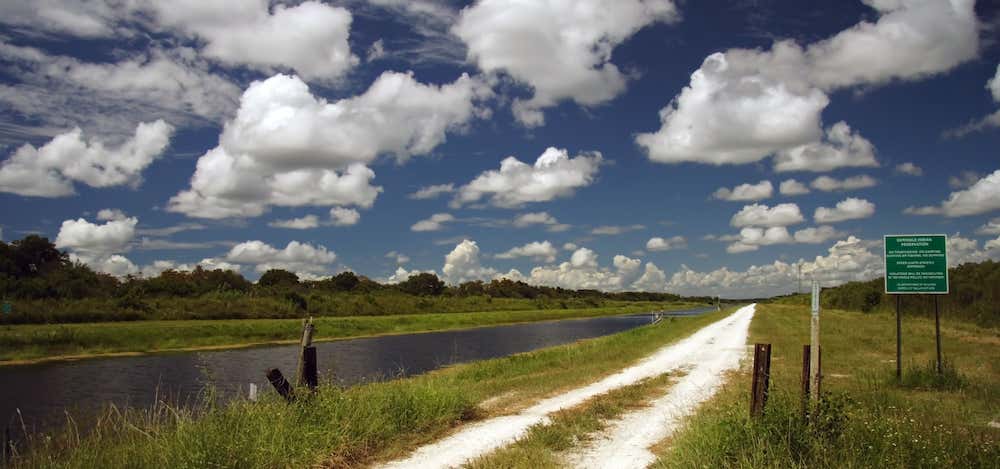To indulge in the total Florida experience, you need beaches, Miami nightclubs, theme parks, space travel memorabilia — and alligators. That's right, alligators. The reptiles are almost ubiquitous in Florida. The state has an estimated alligator population of 1.3 million, and they have been spotted in all 67 counties. Given the size of the gator population, unprovoked attacks on humans — an average of five per year since 1948 — are few and far between (and mostly avoidable according to experts). Floridians have learned to safely coexist with their reptile neighbors, and visitors can easily do the same.
Before taking off on your alligator adventure, keep these important safety precautions in mind:
● Keep your distance. Viewing alligators from the road or from the safety of your car should be perfectly secure, but wandering too close to them is very risky. ● Never feed alligators under any circumstances. ● Don't agitate or tease any alligators you encounter. ● Never swim or wade in areas that could have alligators. ● Don't approach an alligator's nest.
One of the best ways to see Florida alligators in their natural habitat is to head to Alligator Alley in South Florida, the highway that connects the Atlantic Coast to the Gulf Coast in a straight 100-mile shot across the Everglades. Of course, you have to get off the main road to actually see the fearsome, bark-skinned reptiles.
From I-75, take the Snake Road exit (Exit 49) and head north toward Big Cypress Seminole Reservation. This takes you into the heart of the famed "River of Grass," the descriptive term given to the Everglades by author Marjory Stoneman Douglas because of the slow north-to-south flow of fresh water across the tall blades of grass. You'll soon find yourself traveling between roadside ponds with watery run-off from the broad river lapping against the shoulders of the road.
As you cruise through the Everglades, keep your eyes peeled. If the weather isn't too hot or too cold, you may start to notice unexplained trails rippling in the water, as if some kind of creature is moving around below. Keep going and you will eventually see the gators themselves, either lolling near the water's surface with just their snouts and eyes sticking out or sunning themselves on the banks.
"The alligators' reptilian arterial system is reliant on its environment to maintain a comfortable body temperature," explains Melissa Sherman, head of marketing for Billie Swamp Safari, which runs airboat and swamp buggy excursions into the surrounding Everglades on the Seminole reservation. "In chilly weather," she says, "alligators spend hours in the sun, absorbing heat through the bony plates known as osteoderms on their backs. In hot weather, they're more likely to stay in the water to protect themselves against overheating. At night, they feed."
While the alligators tend to be lethargic, they might become aggressive toward approaching humans. Feeding them puts you at risk of being perceived as prey, experts say. "They have a brain the size of a walnut," Sherman says. "They go on pure instinct." That means they have little sense of the difference between food and the person delivering the food. "They'll easily mistake your hand for food," Sherman says. Alligators have as many as 80 teeth, and males grow as large as 14 feet and 500 pounds. It's wise to respect them at all times.
Continue on Snake Road until you reach the town on the Seminole reservation. The locals no longer live in native chickees, or open-sided huts with raised floors and thatched roofs made from palmetto palm fronds, but you will still see historic sites used for tribal ceremonies. The village has a museum and the Billie Swamp Safari attraction, both of which are worth the trip into the Everglades.
The Ah-Tah-Thi-Ki Seminole Indian Museum (the name means "a place to learn, a place to remember" in the Seminole language) features historical displays, including dioramas of 19th-century life in the swamps, where the Seminole people retreated to avoid attempts by the federal government to relocate them. It also boasts Seminole art with its trademark beadwork as well as a 1-mile boardwalk trail from the back of the building through a thick cypress forest.
A couple of miles farther down the road, Billie Swamp Safari operates a well-maintained zoo that is populated mostly with rescued animals. Hop in a Florida swamp traveler's hot rod, otherwise known as an airboat, to spot more alligators in the wild, or simply take your time watching the alligators that live in the circular pond onsite.
Billie Swamp Safari also offers the only commercial restaurant in town, Swamp Water Café, where you can order standards like hamburgers and French fries or local cuisine like Indian fry bread, Indian tacos, and bison burgers. The restaurant is spacious and comfortable and offers a panoramic view of the Everglades, complete with glimpses of airboats and passing wildlife.
Staff at both the museum and the safari attraction are valuable sources of information on those toothy denizens of the surrounding swamp. They can also give you all the details on local snakes and other critters. The excursion is "off the beaten track," acknowledges Carrie D. of the museum's visitors' services staff, but that's part of the adventure. "We like to say the drive is really part of the experience," she says.






